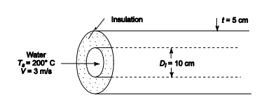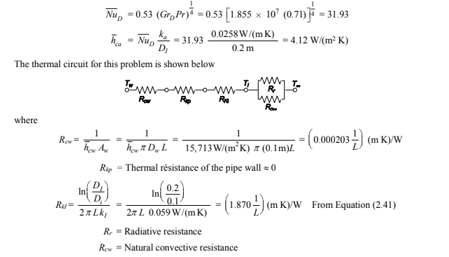Evaluate the rate of heat loss per meter from pressurized water flowing at 200°C through a 10-cm-ID pipe at a velocity of 3 m/s. The pipe is covered with a 5-cm-thick layer of 85% magnesia wool which has an emissivity of 0.5. Heat is transferred to the surroundings at 20°C by natural convection and radiation. Draw the thermal circuit and state all assumptions.
GIVEN
? Pressurized water flowing through an insulated pipe
? Water temperature (Tw) = 200°C = 493 K
? Pipe inside diameter (Di) = 10 cm = 0.1 m
? Water velocity (V) = 3 m/s
? Magnesia wool insulation thickness (t) = 5 cm = 0.05 m
? Emissivity of the wool insulation (?) = 0.5
? Temperature of the surroundings (T?) = 20°C = 293 K
FIND
? The rate of heat loss per meter (q/L)
ASSUMPTIONS
? Steady state
? Pipe surface temperature can be considered constant and uniform
? Surroundings behave as a black body
? Pipe is horizontal
? Thermal resistance of the pipe is negligible
? Ambient air is still
? Pipe thickness is negligible
? Fully developed flow
SKETCH

Heat transfer coefficient on the water side:
The Reynolds number of the water flow is

Applying Equation

Heat transfer coefficient on the air side:
The natural convection heat transfer coefficient on the outside of the insulation is a function of the exterior temperature of the insulation (TI). For a first iteration, let TI = T? + 20° = 40°C. Evaluating the air properties from Appendix 2, Table 28, at the film temperature of 30°C

The Grashof number is

Applying Equation (8.20)

The insulation temperature (TI) can be determined by equating the heat transfer between Tw and TI to that from TI to T?

Checking the units then eliminating them for clarity

You might also like to view...
A filtergram is a photograph of the sun's surface made
a. in a band of wavelengths in the infrared. b. in a band of wavelengths in the ultraviolet. c. using the Zeeman effect. d. with only those photons emitted in a specific spectral line. e. none of the above
If you add 700 kJ of heat to 700 g of water at 70.0°C, how much water is left in the container? The latent heat of vaporization of water is 2.26 × J/kg and its specific heat is 4190 J/(kg ? K)
A) 429 g B) 258 g C) 340 g D) 600 g E) none
Raising the current through a resistor from 8.50 A to 11.3 A increases the power by
A. 33.0%. B. 77.0%. C. 113%. D. 157%. E. 0% (no change).
What part of the Sun's aging process will destroy Earth itself?
a. the fusion of hydrogen in the core b. an increase in luminosity as the core becomes helium-enriched c. the expansion of the outer layers of the Sun as a red giant d. the supernova explosion caused by the collapse of the iron core e. hydrogen detonation on the white dwarf remnant